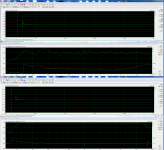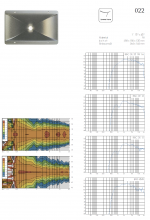Hi Guys
Boy I wish they would put a new curve up for the SH-50, that one is ancient and we have changed it a couple times.
Here are two sets of measurements of one of my RH sh-50 using arta. The first one is “as is” taken at about a meter in my cluttered living room. The especially astute impulse response readers might recognize the reflection of a Ducati close by.
It is not flat as hifi speakers but unlike a flat hifi speaker made with domes and cones, because of he directivity, the measurement at the couch looks very similar. Also, there is no evidence of the phase shift and “all pass” phase shift from high order passive crossovers used in this 3 way system, the point is all the drivers combine into one source in time and space, there are no lobes and nulls in the polar patterns and if you move your head around approaching the mouth you cannot hear there is more than one source floating somewhere in front of you.
Now, cost is an issue, it usually takes three parts for every bump you want to address and when you make a crossover for a speaker that handles that much power, it costs real money. It takes a 780 Watt amplifier with slowly increasing music spectrum pink noise to reach the point where the response shape changes in just one place by 3dB compared to 1W. In other words, they are silly powerful for home use but headroom is your friend . That perception is A real problem in our market where most of the speaker systems are self interfering arrays that maximize the number of drivers, not minimize, here what one see’s doesn’t suggest how powerful it is.
I think these may work as a home product eventually but since the grass is green elsewhere I have not raised much interest at the shop in the home area. There is a recording studio that has taken an interest in trying some tweaked sm-60’s as an in wall main monitor in a new studio so if they like them they will talk about them, well I guess they talk either way.
One thing you can do with these that’s kind’a cool is you can go ahead and do an FIR correction and get rid of the drivers phase and other issues globally. While this is pointless for 95% of the uses at work, this actually makes the speakers I have “invisible” to the ear when producing a mono phantom.
I had saved a shot fooling around with re-phase and opendrc, this was try number two months apart from the raw measurement and a different mic pre setting..
Best,
Tom
Boy I wish they would put a new curve up for the SH-50, that one is ancient and we have changed it a couple times.
Here are two sets of measurements of one of my RH sh-50 using arta. The first one is “as is” taken at about a meter in my cluttered living room. The especially astute impulse response readers might recognize the reflection of a Ducati close by.
It is not flat as hifi speakers but unlike a flat hifi speaker made with domes and cones, because of he directivity, the measurement at the couch looks very similar. Also, there is no evidence of the phase shift and “all pass” phase shift from high order passive crossovers used in this 3 way system, the point is all the drivers combine into one source in time and space, there are no lobes and nulls in the polar patterns and if you move your head around approaching the mouth you cannot hear there is more than one source floating somewhere in front of you.
Now, cost is an issue, it usually takes three parts for every bump you want to address and when you make a crossover for a speaker that handles that much power, it costs real money. It takes a 780 Watt amplifier with slowly increasing music spectrum pink noise to reach the point where the response shape changes in just one place by 3dB compared to 1W. In other words, they are silly powerful for home use but headroom is your friend . That perception is A real problem in our market where most of the speaker systems are self interfering arrays that maximize the number of drivers, not minimize, here what one see’s doesn’t suggest how powerful it is.
I think these may work as a home product eventually but since the grass is green elsewhere I have not raised much interest at the shop in the home area. There is a recording studio that has taken an interest in trying some tweaked sm-60’s as an in wall main monitor in a new studio so if they like them they will talk about them, well I guess they talk either way.
One thing you can do with these that’s kind’a cool is you can go ahead and do an FIR correction and get rid of the drivers phase and other issues globally. While this is pointless for 95% of the uses at work, this actually makes the speakers I have “invisible” to the ear when producing a mono phantom.
I had saved a shot fooling around with re-phase and opendrc, this was try number two months apart from the raw measurement and a different mic pre setting..
Best,
Tom
Attachments
Tom, Thank you for the insight. We have been playing around with FIR Correction and BruteFIR and Audiovolver some time ago, too. Very interesting stuff and in my oppinion one of the "great things to come" in the future.... Even great speakers took a major leap forward in "disappearing and making the box invisible" with the right correction used... Sadly the needed delay for lower frequencies limits the technique für higher bands when used in live-setups.
Your Step-Response looks just great!
Your Step-Response looks just great!
Hi guys,
I am not too worried about these initial measurements.
The major dip at ~9-10k is my non-existent handling of the throat of the compression driver entering the horn. I had originally designed this 'insert' as a solution but have not had anything like it made:
I do agree you get some funny peaks/troughs and some of this is due to the poor measurement by me (I don't have ready access to an anechoic chamber). My bass measurement is pathetic as you can see (for example).
I have done some brute-force correction via the DEQX (which has the handy feature of allowing you to disable the drivers at runtime) and there is definitely no audible distinction in the source of the sound down to 300Hz (where it crosses to the bass drivers) - even as Tom has said - with your head in the horn.
So far I have found that a 300Hz - 128dB/oct and 950Hz - 128db/oct is sounding best but this is playing mono until I can carry the other one to be in place. I have also removed most of the measurement smoothing allowing the DEQX to aim for a flat output. My next step is to try some off axis measurements and see how they look - an initial one looked very similar to my on-axis ones.
Ultimately my goal was to produce an extremely dynamic speaker and I think this will fit the bill.
Tom:
I would be interested to know at approximately which frequencies you crossover in the SH50?
Also, thanks for the inspiration.
Cheers,
Mike
I am not too worried about these initial measurements.
The major dip at ~9-10k is my non-existent handling of the throat of the compression driver entering the horn. I had originally designed this 'insert' as a solution but have not had anything like it made:
An externally hosted image should be here but it was not working when we last tested it.
I do agree you get some funny peaks/troughs and some of this is due to the poor measurement by me (I don't have ready access to an anechoic chamber). My bass measurement is pathetic as you can see (for example).
I have done some brute-force correction via the DEQX (which has the handy feature of allowing you to disable the drivers at runtime) and there is definitely no audible distinction in the source of the sound down to 300Hz (where it crosses to the bass drivers) - even as Tom has said - with your head in the horn.
So far I have found that a 300Hz - 128dB/oct and 950Hz - 128db/oct is sounding best but this is playing mono until I can carry the other one to be in place. I have also removed most of the measurement smoothing allowing the DEQX to aim for a flat output. My next step is to try some off axis measurements and see how they look - an initial one looked very similar to my on-axis ones.
Ultimately my goal was to produce an extremely dynamic speaker and I think this will fit the bill.
Tom:
I would be interested to know at approximately which frequencies you crossover in the SH50?
Also, thanks for the inspiration.
Cheers,
Mike
Last edited:
This has got to be the darling of Constant Directivity builders, the Econowave cult. Thanks to Zilch.
An externally hosted image should be here but it was not working when we last tested it.
Cost about $14.
Clones:
Pyle Pro PH612
Dayton H6512
YD-L033 (Australia)
Dr Geddes performed measurement of this waveguide:
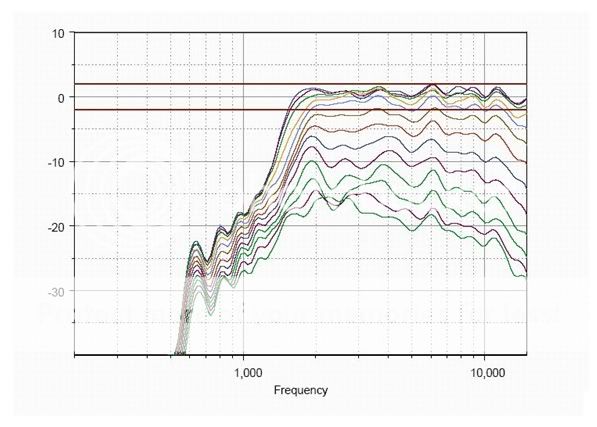
The usage of this waveguide is well established:
Econowave Summary (need to register to see pics & plots)
Use Selenium D220Ti or D2500Ti-Nd, 8 Ohms.
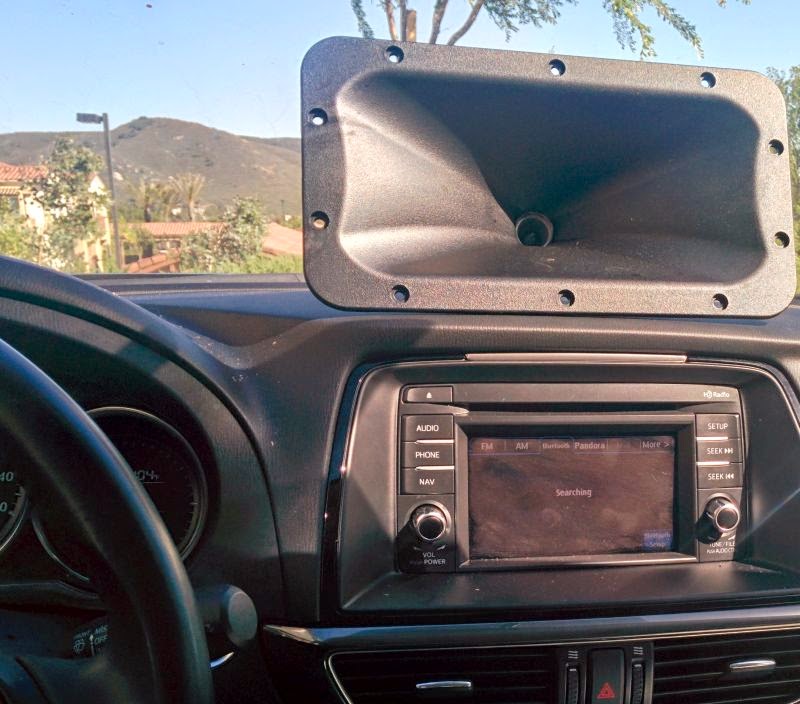
I am working on an ambiopole, and ran some measurements of the Pyle PH612. In my measurements I used a JBL 2408H-1, which goes higher in frequency than the Selenium compression driver used in the Econowave.

Here's the frequency response on-axis and off. I did a groundplane measurement, so one could get a cleaner measurement if they did it off the ground and baffled the waveguide. I have a 1mfd cap wired in series to protect the compression driver from damage. That's why the octave from 1-2khz is basically AWOL.
The lower curve is 45 degrees off-axis, the other curve is on axis. Note that this curve includes the THD levels.
If anyone's curious about my ambiopole, check out the thread titled 'Everything Counts in Large Amounts' at Diyma.
Last edited:

Amazon has been promoting their new robotic factories this week, and I noticed a familiar face in the video.
Is that a Pyle loudspeaker horn? Why yes, it is!
It's not one from the great waveguide list, alas
Here's the full video : http://www.cbsnews.com/videos/robots-help-amazon-tackle-cyber-monday/
Thanks Patrick for the excellent write up about the difference between conical and os horns on page 22. Very clear and very easy to follow for those on the visual side of understanding.
These dips in the frequency that seem to come with conical horns. Any more information on these dips? Maybe there is a CSD measurement known, does thd peak, harsh on the ears or just a dip in freq?
I could be very wrong, but i never have seen felt at the end of Synergy horns, did anybody try this? Or speaking about tech crossovers, anybody try hom foam in a Synergy?
These dips in the frequency that seem to come with conical horns. Any more information on these dips? Maybe there is a CSD measurement known, does thd peak, harsh on the ears or just a dip in freq?
I could be very wrong, but i never have seen felt at the end of Synergy horns, did anybody try this? Or speaking about tech crossovers, anybody try hom foam in a Synergy?
Last edited:
Mr. Danley, how is it possible that your loudspeakers have such a nice imulse response? The mid drivers are located in front of the compression drivers and the woofers in turn are located in front of the mids. How is it possible this does not cause group-delay (i.e. excess phase rotation) for the drivers located farther from the mouth? Aditionally , I can't imagine you are using acoustic first order filters, right?
Last edited:
Mr. Danley, how is it possible that your loudspeakers have such a nice imulse response? The mid drivers are located in front of the compression drivers and the woofers in turn are located in front of the mids. How is it possible this does not cause group-delay (i.e. excess phase rotation) for the drivers located farther from the mouth? Aditionally , I can't imagine you are using acoustic first order filters, right?
It is not based on the physical spacing only, but measured acoustic and electric delay through the cabinet as well. This is where the right combination of drivers, spacing, crossovers, all pass filters, and drivers is a time consuming process to get right.
Best regards,
John
Tom's crossovers are not "standard" designs.
No good crossover is of a standard design when dealing with horns. The crossover is what makes them hard to do. Tom's is a good example and mine as well.
Limmer 022
Price: 75 €
Where to buy: some shops in europe
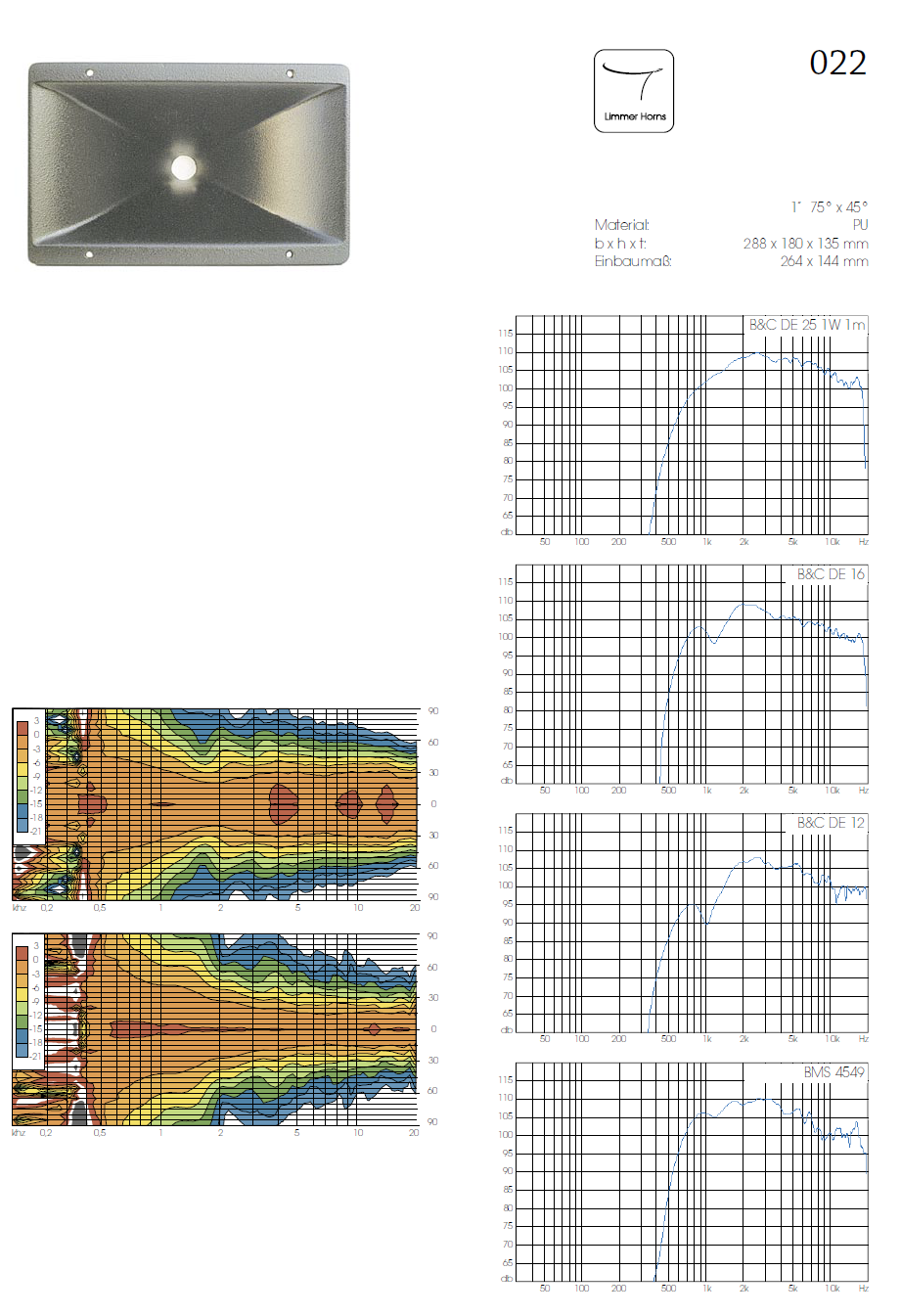
Limmer Horns is a small german company with high reputation. They have no website. The catalog can be requested by phone. Here is an overview of their horns with datasheets.
Price: 75 €
Where to buy: some shops in europe
Limmer Horns is a small german company with high reputation. They have no website. The catalog can be requested by phone. Here is an overview of their horns with datasheets.
Attachments
Limmer Horns is a small german company with high reputation. They have no website.
Coincidence or related?
none 
Mr. Limmer is well known in the industrie and doesn´t need to focus on end-users. Not every company needs to think about global market, having a webshop where end-users can browse.... Mr. Limmer is behind many very successfull designs on the market and the engineering departments in Europe know him very well. He is happy not having 27877 employes and sourcing out production to Asia to compete with low-price brands. A simple 1" Horn for a small compression driver is about 99 Euro - seems expensive, but you get a hand crafted, very rugged flare/horn with excellent sonic features - and this is what companies want in a certain product range..
Mr. Limmer is well known in the industrie and doesn´t need to focus on end-users. Not every company needs to think about global market, having a webshop where end-users can browse.... Mr. Limmer is behind many very successfull designs on the market and the engineering departments in Europe know him very well. He is happy not having 27877 employes and sourcing out production to Asia to compete with low-price brands. A simple 1" Horn for a small compression driver is about 99 Euro - seems expensive, but you get a hand crafted, very rugged flare/horn with excellent sonic features - and this is what companies want in a certain product range..
Okay I believe that, but all-pass filters? Those are pretty hard to do in a passive network and don't work across a wide band. I hope Tom will chime in.
They can be done in a passive network, but usually get complicated (lots of inductors and caps). In a multiway system they don't have to work across a wide band.
There are some examples that come in the install for Xsim, my (free) passive crossover simulator, there should be a link below.
But that being said, for that much effort and money, it would usually be easier to use a FIR filter setup to straighten the phase and magnitude (at some point in space) if that's the goal.
- Home
- Loudspeakers
- Multi-Way
- Great Waveguide List
